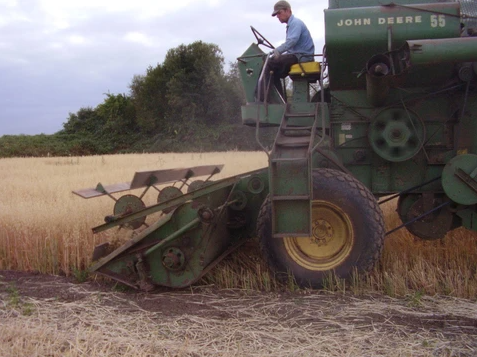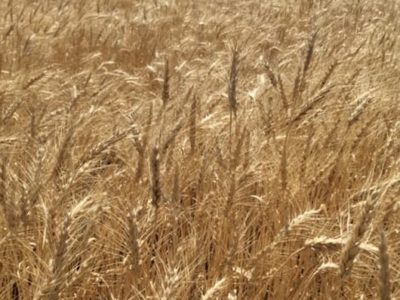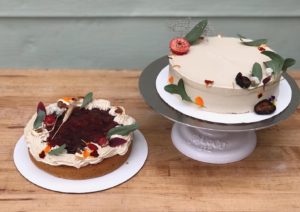We might not always step into the kitchen to bake thinking that we are about to partake in an agricultural act. However, the act of baking and the staple ingredients we use intersect with so many parts of the food chain. From seed sovereignty to soil health, biodiversity to cultural heritage, the flours on our pantry shelves tell a much deeper story than we are often led to believe. For a long time, flour has been treated as an anonymous white powder; merely an ingredient sitting on the shelves of grocery stores; far too often left out of the rise in folks interested in regional foods with traceable origins. However, we are lucky to live in the presence of a vibrant community of farmers, millers, bakers, brewers, and advocates working at the intersection of sustainable farming, biodiversity, and food culture working to revitalize our Pacific Northwest grain economy. With the holiday baking season upon us, now is the perfect time to ramp up your use of diverse local grains in your recipes.
Celebrating the diversity of grains available in our region by baking with the whole grainbow (a term via Annie Moss of Seastar Bakery and Adrian Hale of Thousand Bites of Bread) is not only delicious and more nutritious, but it also supports soil health, reduces food transportation emissions, generates support for small-scale sustainable farmers working to bring staple foods to the community, and makes the taste of place one of your ingredients. One of my favorite things about sourcing local grains is that it restores the role of relationships at the heart of baking. Not only do you get to form relationships with the people behind your flours – inviting their stories and care into the kitchen with you – but when biodiversity becomes a cornerstone of your baking practices, each time you use a different grain in a recipe you get to enter into a new relationship with flavor, texture, color, and aroma!
As I think about the waves of lost grain biodiversity and the resurgence of farming and food activists bringing it back, it is important to name the complex histories and enduring legacies folded within the culture of grains. I want to ask us – as bakers, farmers, millers, eaters, consumers – to hold space for the knowledge that many of the grains grown as staple foods on the (stolen) landscapes we call home arrived here only by way of processes that inherently involve colonization and Indigenous erasure (as is the case with so many food crops). To start dive deeper into this topic, check out The Center for Regional Agriculture, Food, and Transformation’s recent virtual conference, Grains & Revolution featuring conversations with bakers, millers, and culinary historians (including PFM vendor Adriana Azcárate-Ferbel of Three Sisters Nixtamal!) seeking to decolonize the practice of baking and brewing by using grain as a vehicle for revolution.
For me, baking is always an act rooted in community care. By supporting local grain producers, we can extend that care backwards in the timeline of our baking to the moment a seed was planted. Many supporters of a local food system will have undoubtedly heard Wendell Berry’s adage, ‘Eating is an agricultural act,’ let’s remember that baking is too.
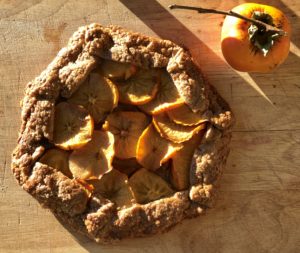
Choose-your-own-adventure Rye Galettes
The recipe included below is an ode to a match made in heaven: butter and grains. One of my core philosophies in baking is that often less is more: a few ingredients handled with care, ceremony, and reverence is all you need to explore the identity and flavor that fresh, locally-sourced grains bring to a recipe. Butter is the perfect carrier vessel for these flavors. Something like an all-butter pastry crust or a shortbread cookie is a simple, humble, but perfect way to put the flavor of grain itself front-and-center.
This dough uses soft white wheat pastry flour and dark northern rye to create a delightfully flakey pastry ready to be filled with seasonal delights, sweet or savory. Rye flour is malty, earthy, nutty and rich in taste. As a crop, rye has a history of resilience that I love to channel when I bake with it. It began its life as a weed that contaminated wheat fields. But because it can be grown in poorer soils, with less sun, more moisture, and in higher altitudes than wheat, it has carried forward an honorable legacy of resilience and survival in the face of struggle. This cereal grain that has been grown for millennia has a deep cultural history, dripping with tradition. I personally think that we have a lot to learn from the ecology of rye!
Soft white pastry flour has a delicate texture and softness that is perfect for creating flakey crusts and a soft crumb in cakes. The ‘white’ does not refer to the same thing as when you see a bag of ‘white flour’ on the shelves of a grocery store, but rather refers to the type of wheat. Wheat can be divided into categories based on its physical and growing characteristics: kernel texture (soft/hard), kernel color (red/white) and seasonality (winter/spring). Because soft and white wheats contain lower levels of protein, they are excellent for use in pastry.
I am a big believer that you don’t actually need a recipe to make a perfect galette—in its nature, a galette embraces and empowers the role of intuition, imperfection, improvisation and creative expression in the home cook. This dough is a sturdy vessel for a hearty, satisfying, nourishing vegetarian dinner served with a simple side salad. I mean, it is hard to go wrong with a pile of seasonal vegetables and maybe some cheese tucked into a blanket of buttery, flakey whole grains. Loaded with fruits, and perhaps served with a dollop of softly whipped cream, it is the perfect sweet way to end a night. Keep this dough recipe in your back pocket and use it as a building block for sweet and savory galettes all year long to fill with farmers market bounty as the seasons evolve.
This recipe is meant to be a guide not a doctrine, please use whatever ingredients you are excited about in whatever portions you want! I made this with persimmons because I am simply astounded by their sweet, rich, almost honied flavor and poetic texture this time of year, but it is perfect with apples or pears (or both!) which are available at the market through the winter. If you stored summer fruits away in the freezer you can pull those out and put them in directly (no need to defrost first). If you want to make it a bit more luscious of a dessert you can spread a layer of hazelnut frangipane (a simple puree of nuts, butter, sugar, eggs, and vanilla) underneath the fruit.
Rye galette dough:
1 ½ cups (205 grams) soft white whole wheat pastry – available year-round at PSU Farmers Market from Lonesome Whistle and Sun Gold Farm
2/3 cup (80 grams) whole grain dark northern rye four – available year-round at PSU Farmers Market from Lonesome Whistle and Sun Gold Farm
1/2 lb (225 grams, 2 sticks, 1 cup) butter – available at PSU Farmers Market from Lady-Lane Farm
1 tsp salt
1 Tbsp sugar (optional)
1/3 cup ice water
A sweet winter filling:
3 very ripe persimmons, apples or pears, sliced medium-thin around the equator
1 egg or 1 Tbsp heavy cream, for wash
Coarse sugar, for sprinkling (optional)
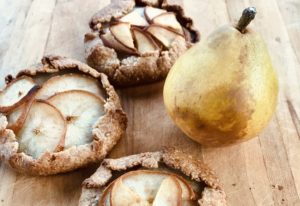
A savory winter filling:
1 bunch of kale, chopped and sautéed with garlic, olive oil, and salt and pepper to taste
a few tablespoons of tangy goat cheese
1 kabocha squash, sliced into thin half-moons and roasted until just barely tender (remember, they will keep cooking when the galette goes into the oven)
Directions:
- Add the flours, salt, and sugar (if using) to a large bowl and mix together using a whisk or a fork.
- Add the cold butter to the bowl and using your finger tips or a pastry cutter break it apart into pieces roughly the size of peas or broken walnut pieces.
- Add ice water slowly until the dough is just wet enough to hold together if squeezed between your fingers, but is not sticky or wet. You may not need all the water, or you may need an extra teaspoon or two if the dough still feels too dry to bring together.
- While the dough is still crumbly, (with confidence) dump it out onto your counter and use your hands to bring it into a single mass. Laying down a piece of plastic wrap to capture the crumble can help make cleanup easier.
- Wrap the disk in plastic wrap or beeswax wrap and rest it in the refrigerator for at least 30 minutes before rolling out. This is a great time to go for a walk and take notice of the seasonal sights, smells, and textures of your local environment. Breath a sense of gratitude and reciprocity that you can imbue in your galette during the next step.
- When you are ready to bake, preheat the oven to 375. Line a baking sheet with parchment paper. On a lightly floured (you can use any flour here, I use pastry flour) surface, roll out the dough into a ~12” circle/oval (embrace the “rustic” nature of a galette here) about 1/8-1/4 inch thick. Some words to think on while you roll out this dough, via Samin Nosrat: “A pie dough is somewhere at the intersection of flaky and tender.” Transfer the dough to the baking sheet.
For a winter sweet galette:
- Arrange the sliced persimmons, apples or pears in a nice pattern in the middle of the round, leaving about a 1 ½ -inch border around the edges. Fold the dough up and over the edges of the fruit center, crimping to create corners. You can always nestle a few pats of butter atop the fruit at this stage, for good measure.
- Brush the top of the crust with egg wash or cream using your fingers or a pastry brush. Sprinkle with coarse sugar.
- Bake for 30-45 minutes (or longer) until the crust is fully baked through and the fruit is soft and juicy. The rye in the crust will make it look darker than a pie crust. Err on the side of longer in the oven and be sure to give it enough time to develop a deep color.
For a kale, kabocha squash and goat cheese galette:
- Follow the same steps as above but omit the sugar when making the crust.
- After rolling out the dough, spread a layer of goat cheese in the middle, mound a towering pile of sautéed garlic and greens (squeeze out any extra water after sautéing to make sure the dough doesn’t get soggy) and arrange slices of roasted kabocha squash in a fan-like circle. Bake as above.
- Serve with more goat cheese on top and a drizzle of olive oil.
Regional Grains + Seasonal Fillings All Year Long:
Spring • roasted asparagus + goat cheese + garlic scapes • rhubarb + a glug of whiskey + sugar + a spoonful of whole wheat pastry flour •
Summer • cherry tomatoes + abundant herbs + feta • plump apricot halves + ricotta + a bit of honey •
Autumn • sautéed wild mushrooms + caramelized fennel + sharp alpine style cheese • fig and honey and thyme
About the Author:
Katie Gourley is a born-and-raised Portlander who has worn many hats in the food system over the years, as a baker, zine writer, farmers market manager, cheesemonger, and seed saver. As a baker, Katie is motivated by regional whole grains, wild fermentation, and the creative ways we can engage with the natural world around us in more caring and careful ways through food. She sees baking as a platform for biodiversity activism and the everyday grassroots ways we enact alternatives to capitalism. You can order custom cakes or zines from Katie via Instagram.

